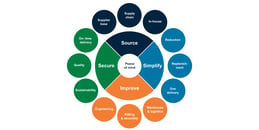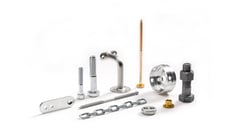Committing to increased sustainability to achieve success is increasingly vital in today's business environment. Manufacturing companies like yours face pressure from governments, owners, shareholders, and customers to make their value chain more sustainable from start to finish. Businesses that previously had to deal with complex production processes and worldwide supply chains now have to analyze how they impact the environment and develop concrete plans to reduce this impact as much as possible.
This pressure will only increase as the regulatory environment changes and sustainability moves up your agenda. This means manufacturers who have just started their sustainability journey must catch up.
The bolts, nuts, screws, and all the other small items that make up your C-parts inventory may seem like a tiny part of your business, but they still play an important role in sustainability. C-parts supply chains have the potential to make or break your company’s overall sustainability journey, just like the supply chains for your other categories of parts. No one wants to have a journalist asking questions about discovered child labor in your supply chain. As a purchaser, your decisions are crucial in reducing these adverse effects and ensuring you meet your company’s sustainability targets.
In this guide, we’ll summarize the key knowledge you need to have about C-parts supply chain sustainability – from a basic explanation of what supply chain sustainability means to concrete measures that can improve the sustainability of your C-parts. Use the links in each chapter to learn more about each topic in more detail and download the guide to C-parts sustainability trends to understand how companies like yours are adapting.
Chapters
Chapters
What is C-parts supply chain sustainability?
To understand what supply chain sustainability entails and how it relates to your C-parts, we can start with the definition of sustainability. In 1987, the United Nations made this claim:
Humanity has the ability to make development sustainable to ensure that it meets the needs of the present without compromising the ability of future generations to meet their own needs.
In short, sustainability is a way of thinking that ensures human activities that create growth and development can be sustained well into the future. It doesn’t mean placing limits on performance or success – instead, it’s a way of ensuring that future generations can also enjoy these things. This is achieved by using the Earth’s natural resources wisely, reducing emissions to ensure a healthy environment and taking long-term business decisions that benefit society and the economy.
In your company’s sustainability work, you’ll probably see the topic of sustainability split into these three categories:
- Environmental sustainability – This is what most people think of when they think of sustainability. It involves, among other things, preserving natural resources, minimizing carbon emissions, and having as little impact on the environment as possible.
- Social sustainability – This category involves the business’s impact on people, such as employees across the value chain, customers, local communities, and society.
- Economic sustainability – This relates to business practices that positively affect the broader economy, as well as employees and suppliers, and create opportunities for long-term growth.
The process of building a supply chain optimized to minimize its negative environmental, social, and economic impacts and enhance its positive ones.Every stage of a supply chain needs to be sustainable, from the extraction of raw materials to the distribution of a finished product and end of life handling.
However, modern supply chains are huge and complex systems. C-parts supply chains in particular can be highly fragmented and unconsolidated. For this reason, participating companies in the UN Global Compact, a worldwide group of organizations committed to sustainability, consider supply chains to be the most significant barrier to improving their sustainability performance.
Why is supply chain sustainability important?
In the past, sustainability has been seen as merely a ‘nice-to-have’ initiative that improves a company’s image. But it’s increasingly becoming a pivotal factor in a company’s business success. To understand why you should use your limited time and resources to improve C-parts supply chain sustainability, consider these three factors:
Environmental benefits
When buying consumer goods today, you’re bound to see companies promoting the recycled and eco-friendly materials used in their products. This is a positive development, but most of a manufacturing company’s environmental impact comes from its supply chains and not its final in-house production of the end product. According to a 2016 report from McKinsey, around 80% of a typical company’s total greenhouse gas emissions are generated in the supply chain, and more than 90% of the total impact on ‘natural capital’ – the world’s stock of natural resources such as minerals, soils, water and air.
If your company wants to improve its overall sustainability, you are best off taking a cradle-to-grave perspective, starting with the product design. During product development, all aspects of the supply chain need to be evaluated, and decisions to be taken wisely. Choices that seem to be the best at present might soon in future be surpassed by a new possibility. To become and remain optimized, you need in-depth knowledge of all parts of your supply chain, or work with reliable partners to do the job for you.
For the choice of fasteners or even fastening methods, you need to think not only of product function, quality, and durability but also of how the product and fastener can be recycled or reused. In the example of a fastener, it is typically a good choice to have the fastener in a material that can be melted together with the material it is bound to. Similar or other considerations must be applied to all parts of an end product.
Having said this, the most significant changes to existing products can be made in the supply chain.
New sustainability regulations
Many national and international regulations are already in place to prevent companies from adopting unsustainable practices. The second half of the 20th century saw a global surge of laws intended to prevent companies from polluting the environment through their manufacturing operations or products.
These regulations have been a fact of life for decades. Still, in the 2020s, we will see the introduction of more new laws and regulations that will increase the operational and financial cost of acting unsustainably. Take the EU’s Corporate Sustainability Reporting Directive (CSRD) as an example. In 2024, large companies will have to start reporting on their sustainability work as they report on their finances today. Importing goods from the Far East will become more difficult with the introduction of additional emissions regulations and anti-dumping laws.
More regulations are bound to follow, and their effects will make sustainability work essential to running a successful company. Many companies will not be prepared for these changes, but rest assured that those who prepare and are ready will have the advantage.
You can find more knowledge about these coming regulations and the impact they will have on your business in this article: Sustainable C-Parts: What You Need to Know.
Find out more about the impact these market demands are already having on C-parts purchasers in this article: C-Parts Purchasing: Handling Your Sustainable Purchasing Policy
Market demands
Regulations are one pressure point that will push manufacturers toward sustainability. But the demands of the market are equally powerful. Sustainability is becoming an increasingly important deciding factor for consumers when making buying decisions, and many companies are already responding to this. Companies that manufacture consumer goods will face customers with stringent product sustainability demands, but soon also for the business practices of the companies that produce them. Fairly soon, having a sustainable supply chain and an ongoing commitment to sustainability will be essential for a company that wants to attract new customers.
What role do C-parts have to play in supply chain sustainability?
When it comes to your company’s entire supply chain, all parts are important – from the smallest screw to the most powerful motor. Each of these parts has its own complex supply chain, and you need information on each one to comply with coming regulations and improve your sustainability.
C-parts typically do not get the attention they deserve in manufacturing companies and are sometimes treated as an afterthought compared to other kinds of parts. Even though a single part might be insignificant, your total C-parts stock is a significant contributor to your emissions and your company’s overall environmental impact.
For a single steel bolt to be manufactured, raw materials are extracted and transported to a steel mill, where they are turned into steel in an energy-intensive process. The steel is transported to a bolt manufacturer, who uses a great deal of energy to turn the steel into bolts, which are checked, packaged, dispatched for delivery, transported to the end user over long distances, unpacked, put away, and eventually used in a product. Even once the product is manufactured, it is shipped to an end user and used until it is disposed of or recycled.
When looking at the complex processes behind your C-parts, you realize the amount of emissions and labor required to get them to you. At each stage in the process, there is the potential for sustainability improvements, whether in the extraction of raw materials, product manufacturing, transport, and shipping, or in the treatment of the workers involved. When multiplying this process across all your C-parts and suppliers, you can see the impact these minor parts have on the overall environmental impact that your company’s activities create.
Supply chain sustainability challenges and C-parts
C-parts generate some unique supply chain sustainability challenges that you’ll likely be aware of. In our work with customers, we generally find three main C-parts challenges that have an outsized impact on the overall supply chain sustainability:
- Unconsolidated supplier bases
- High MOQs
- Inventory management challenges
Unconsolidated supplier bases
C-parts are small, inexpensive, and seemingly unimportant components. This is part of why many manufacturers haven't invested time and money in consolidating their supplier bases for this category of parts, as they may have done with their more expensive, bulky, and visible components. This is surprisingly often the case even if the added impact of all C-parts in all products has a significant impact on the company footprint.
This leads to a situation where major manufacturers can easily have tens or sometimes hundreds of individual C-parts suppliers. Each one has a different invoicing and ordering system, which is challenging for a purchaser – but they also each have their own production facility, manufacturing methods and shipping processes. Restocking a few different parts can therefore involve multiple international shipments and truck deliveries of the needed parts to your factory. This inefficient and unconsolidated approach generates a lot of emissions, far more than would be produced if a single supplier sent one shipment of all the needed parts straight to you.
C-parts supplier bases are generally much less consolidated than other parts, so it's essential to be aware of this when assessing and improving your supply chain.
High MOQs
Some manufacturers who deal directly with C-parts suppliers struggle with high minimum order quantities (MOQs). If a manufacturer needs 1 000 pieces of a single item, but the supplier has a MOQ of 2 000 on the item, the manufacturer is sometimes forced to place the larger order. This increases costs, takes up space in the parts store and increases the risk of obsolescence. If the product they are used in is discontinued or if an improved design is adopted, the parts may not be required anymore – leaving the manufacturer with a surplus of components that may need to be discarded or recycled. The material used in the parts and the energy required to ship them have been wasted, and the manufacturer's environmental impact has unnecessarily increased.
High MOQs are more common for C-parts than other parts, creating a problem affecting overall supply chain sustainability. As a manufacturer, you must communicate with your supply chain to avoid obsolescence, scrap, and unnecessary environmental impacts.
Inventory management challenges
C-parts inventories are characterized by large quantities of parts and wide variation. A car manufacturer, for example, may only use three or four types of door panels in their vehicles, but hundreds of different kinds of fasteners. This fact, coupled with the common perception that it isn't worthwhile to invest time and money into streamlining C-parts management, often means that manufacturers have an insufficient overview of their C-parts inventory.
In practice, this can result in shortages of essential parts that are often discovered too late. In these situations, the manufacturer has two choices – stop production, or get an express shipment of the needed parts. Due to the high cost of downtime, express shipment is often the best choice – but it comes at the cost of inefficiency and very high emissions, especially if the parts are freighted by air.
A- and B-part inventories are typically managed more efficiently – so they usually aren't responsible for the same sustainability issues C-parts can easily create.
There are more details on other aspects of the sustainability challenges around C-parts in this article: Sustainability Challenges with C-Parts and How to Solve Them.
How to improve your C-parts supply chain sustainability
Assessing an existing supply chain and then taking concrete steps to improve its sustainability is a significant task that all companies like yours must manage in the coming years. No single action can sum up the work that needs to be done. Instead, it will be a collective effort from team members across purchasing, production, planning, R&D, logistics, and management to carry out the supply chain's due diligence to follow regulations and mitigate risks. However, these three steps will be critical for a company that has already realized the importance of sustainability and is taking steps to transform its C-parts supply chain:
Develop a sustainability policy
A sustainability policy provides a solid foundation that your practical sustainability work will build upon. Multiple departments and competencies are required when trying to optimize something as complex as a C-parts supply chain. A sustainability policy aligns the organization around one shared mission and sets the plan's framework. When created by the right people and accepted by the company’s leadership, a sustainability policy ensures that the company's energy is focused on the right places. For more insights into what a sustainability policy actually looks like and how other companies have created them, take a look at this article: How to Fulfil Your Sustainability Policy in C-Parts Purchasing
Set your KPIs
The sustainability policy is the bedrock of your supply chain sustainability work, but its purpose is to provide a broad vision. To actually measure performance and goal completion in each department, key performance indicators (KPIs) need to be developed. These KPIs will look different depending on the nature of your company and industry, but some typical sustainability-related KPIs that other manufacturers measure themselves on include:
- Emissions generated by the company's activities – This will likely be the top-level KPI to which all sustainability work will be related. It should include the scope 1 and 2 emissions that are closely related to your company – for example, the emissions created by company vehicles or the generation of the electricity that powers your office. But scope 3 emissions are just as important, and harder to define. These are all the emissions created indirectly throughout your supply chain and distribution network.
- The number of suppliers – This KPI is likely to be the responsibility of purchasing. Each of your C-parts suppliers has its own production processes and shipping methods. But by consolidating suppliers, you also consolidate shipments – receiving the same number of parts in fewer deliveries. Considering many European manufacturers source their parts from suppliers in Asia, reducing the total number of deliveries can make a noticeable difference to your total C-parts supply chain emissions.
- The number of express deliveries – Planning, production and purchasing all need to be involved to achieve satisfactory results here. Express shipments are sometimes necessary, but they're inefficient. By improving communication between production and purchasing and implementing inventory management or VMI solutions, parts shortages and the need for unexpected express deliveries can be kept to a minimum.
If you would like more information on relevant sustainability KPIs that can provide important goals for your C-parts purchasing, take a look at this article: Sustainability Targets and KPIs to Implement in the Purchasing Office.
Work with sustainable sourcing
The KPIs above primarily focus on emissions, an essential part of the bigger picture. But environmental, social, and economic sustainability enabled by correct sourcing practices is just as important. This means selecting suppliers based on socially sustainable metrics, such as working conditions, labor agreements, and legal compliance. Environmental factors, such as the supplier's waste management processes and energy use, are another side of the coin. When it comes to economic sustainability, it's about finding serious suppliers you can build a long-term relationship with, which will facilitate all your other sustainability ambitions in the long run. Price is an important factor for all purchasers, but ensuring suppliers share your sustainable aspirations and help work towards them will reap greater benefits in the long run.
If you're interested in learning more about sustainable sourcing, this article will be of interest: What is Sustainable Sourcing?
Get the guide to sustainable sourcing trends that affect you
Hopefully, this guide has given you some insights into the importance and complexity of C-parts supply chain sustainability. To find out more about the sustainability demands that you'll face in the future and how to get prepared for them, make sure to download our free guide below – The Manufacturer's Guide to Sustainable Sourcing Trends.









